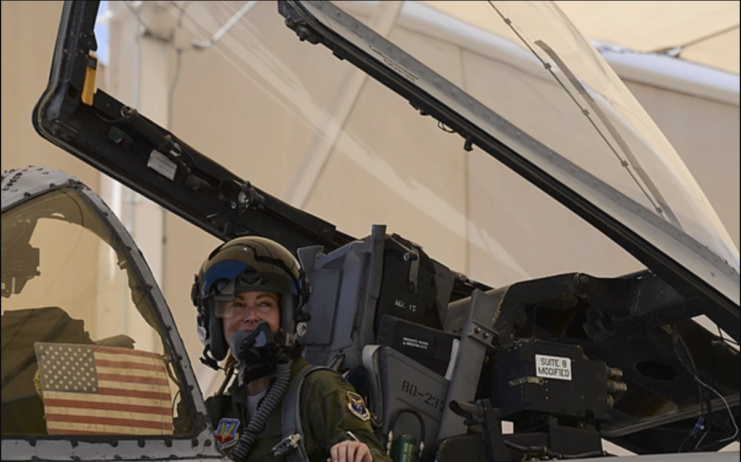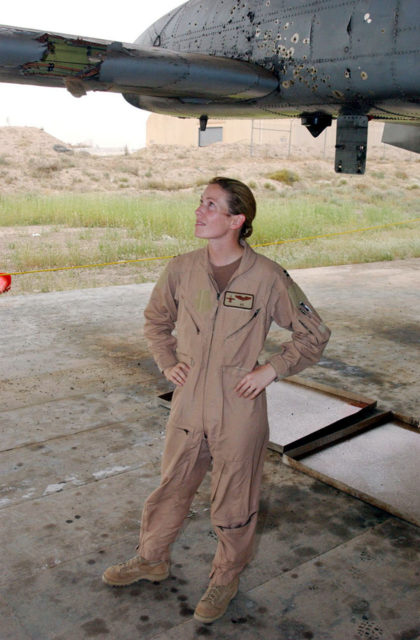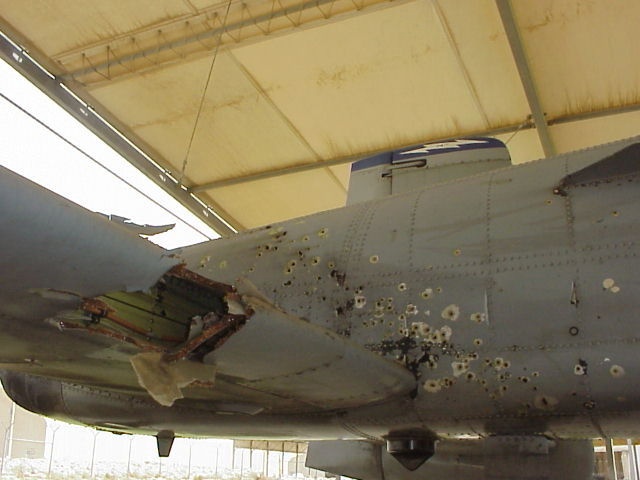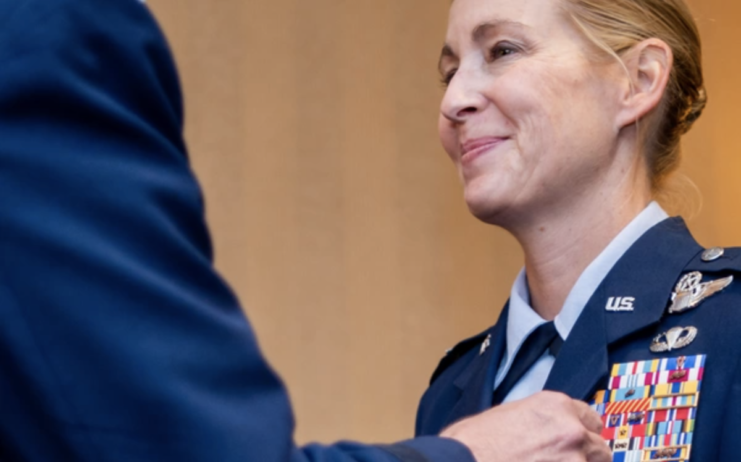Kim ‘Killer Chick’ Campbell: One of the Few USAF Pilots to Manually Land an A-10
Kim Campbell #KimCampbell

Kim “Killer Chick” Campbell is an Air Force pilot who completed an incredible manual flight and landing in Afghanistan on April 7, 2003, when her Fairchild Republic A-10 “Warthog” Thunderbolt II was struck by an enemy missile that took out the aircraft’s hydraulics. Her incredible skills as a pilot allowed her to safely return to the air base without risking her life, the life of her flight lead, or causing any further damage to the plane.
The trouble with flying that day  Kim Campbell sitting in a jet. (Photo Credit: Airman 1st Class Kristine Legate / DVIDS / Public Domain)
Kim Campbell sitting in a jet. (Photo Credit: Airman 1st Class Kristine Legate / DVIDS / Public Domain)
Her original mission that day was to attack an Iraqi command post in Baghdad but while flying in, she and flight lead Lt. Col. Rick “Bino” Turner received a call that 3rd infantry division soldiers were under fire and required air support. On their way in, she and Turner had to take into consideration civilian casualties and infrastructure before they could make any gun runs, especially since this was the most intense situation she had seen in Afghanistan so far.
Threats and conditions caused Campbell to approach very carefully as she flew the aircraft into Baghdad. Surface-to-air missiles could easily knock the plane out of the sky and ultimately make the situation in Baghdad worse. The sky over the city was also very cloudy, which did not allow Campbell and Turner to remain at a higher and safer altitude. If they flew too high, they would lose sight of the city below.
Taking multiple passes and firing rockets and 30mm bullets at Iraqi fighters, Campbell and Turner’s flight seemed a success. But on their last pass, the back of their A-10 was struck by an orange fireball and the plane began to fall to the ground. The hydraulics system was compromised.
Trained to manually fly  USAF Pilot Kim Campbell looks at her damaged A-10 Warthog which she landed at her base after a mission over Baghdad in 2003. (Photo Credit: SSgt Jason Haag / United States Air Force / National Air and Space Museum / Wikimedia Commons / Public Domain)
USAF Pilot Kim Campbell looks at her damaged A-10 Warthog which she landed at her base after a mission over Baghdad in 2003. (Photo Credit: SSgt Jason Haag / United States Air Force / National Air and Space Museum / Wikimedia Commons / Public Domain)
Immediately, Campbell’s flight training kicked in. The first thing she did was figure out how to maintain control of the aircraft. “In an emergency situation like that, I felt like time slowed down,” she recalled. “I knew I had to take quick action but I also had to figure out what was going on in my cockpit.” Her solution was to manually fly the A-10.
Although it is extremely difficult, the A-10 is one of the few aircraft that can even operate without hydraulics. It’s equipped with a manual reversion system that allows the pilot to continue to fly in emergency situations. “Aircraft control in the manual flight mode is exceptionally demanding of piloting skills,” the Air Force Human Resources Laboratory wrote in a 1982 report on the manual reversion system.
Campbell had to re-teach herself how to manually fly – while being shot at by anti-aircraft fire. Thankfully, her skills as a pilot are honed enough that she didn’t struggle too much with this. “Once I flipped the switch to manual reversion, I don’t remember it being overly difficult,” she said. “I was just so relieved the airplane was finally climbing and responding.”
Campbell and Turner were able to get out of the combat zone relatively unscathed after their critical hit, and Campbell manually flew that A-10 for 300 miles to Kuwait.
Landing manually is a different ball game  A heavily damaged A-10 Warthog which was successfully landed back at a USAF Air base by pilot “Killer Chick” Kim Campbell. Damage was sustained over Baghdad in the spring of 2003. (Photo Credit: SSgt Jason Haag / United States Air Force / National Air and Space Museum / Wikimedia Commons / Public Domain)
A heavily damaged A-10 Warthog which was successfully landed back at a USAF Air base by pilot “Killer Chick” Kim Campbell. Damage was sustained over Baghdad in the spring of 2003. (Photo Credit: SSgt Jason Haag / United States Air Force / National Air and Space Museum / Wikimedia Commons / Public Domain)
Campbell had an entire hour to get used to flying the A-10 manually. Manually landing, however, is an entirely different ball game. Without hydraulics, minute adjustments are much more difficult to execute. It is so difficult, in fact, that the checklist for manual reversion is to “attempt only under ideal conditions,” which Campbell clearly did not have. The aircraft had hundreds of small holes in it and a larger hole in the right horizontal stabilizer. It was also facing enemy fire.
She and her flight lead, Lt. Col. Turner, discussed their options and after weighing the risks, Campbell decided to “go for it.” “[Turner’s] actions after I was hit were absolutely critical,” Campbell later said. “I was so focused on flying the airplane, getting it under control, whereas he had more awareness of what was going on around me.”
Campbell landed the A-10 just fine. She later received the Distinguished Flying Cross, one of the Air Force’s highest awards, for her flight and landing that day. Lt. Col. Mike Millen, chief of the 355th Fighter Wing Commander’s Action Group and an A-10 pilot, said “Kim landed that jet with no hydraulics better than I land the A-10 every day with all systems operational.”
Surprisingly, when Campbell later attempted manual landings in simulators, she was not successful every time. Thankfully, the time that she actually did it in a real-life situation, when it truly counted, her landing was successful.
Campbell went right back to it  Kim Campbell receiving an award. (Photo Credit: Staff Sgt. Danny Rangel / 12th Air Force (Air Forces Southern) Public Affairs / DVIDS / Public Domain)
Kim Campbell receiving an award. (Photo Credit: Staff Sgt. Danny Rangel / 12th Air Force (Air Forces Southern) Public Affairs / DVIDS / Public Domain)
Despite her bravery in the moment, Campbell admits that deep down somewhere, she was scared. “When I go back and listen to the audio recording [of the flight], I can hear the fear, I just didn’t have time to think about it,” she recalled. Regardless, Campbell hopped back into the cockpit the next day. She said, “I didn’t have time to think about how I was going back to the place I was nearly shot down.”
More from us: The Remarkable North American P-82 Twin Mustang Was Two Aircraft In One
Now retired, Campbell amassed 1,800 hours of flying time and more than 100 combat missions in the A-10. For her, it was all about being a great pilot. “I never wanted to be labeled as a female fighter pilot,” she explained. “I wanted to be the best pilot. So just work hard and be credible. Be good at what you do.”
Samantha Franco
Samantha Franco is a Freelance Content Writer who received her Bachelor of Arts degree in history from the University of Guelph, and her Master of Arts degree in history from the University of Western Ontario. Her research focused on Victorian, medical, and epidemiological history with a focus on childhood diseases. Stepping away from her academic career, Samantha previously worked as a Heritage Researcher and now writes content for multiple sites covering an array of historical topics.
In her spare time, Samantha enjoys reading, knitting, and hanging out with her dog, Chowder!